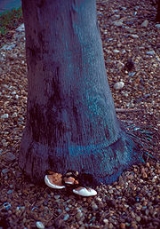
Ganoderma zonatum
Encyclopedia
Ganoderma zonatum is a plant pathogen that infects the palm species
causing butt rot
. It is a fungus that infects the bottom 4 –5 feet (120 – 150 cm) of the plant also rotting the root
s. It has been known to be in both natural and planted environments and in the majority of cases only in palms.
and slow growth. However this is noticeable in many different plant diseases and can not be used as a diagnosis tool. There are only two ways to fully identify G. zonatum. One is the bacidocarp
(or conk) forming on the plant with the other viewing the internal rotting of the palm on the inside once it has been cut down.
s produced in the bacidocarp. The spores land on the soil and germinate. The hyphae then grow over the plant roots and up into the woody trunk
. The fungus damages the palm trunk closest to the soil first, expands in diameter and moves up the center of the trunk causing a cone like shape of infected trunk. When the bacidocarp emerges it is at the highest point at which the fungus will internally grow.
Arecaceae
Arecaceae or Palmae , are a family of flowering plants, the only family in the monocot order Arecales. There are roughly 202 currently known genera with around 2600 species, most of which are restricted to tropical, subtropical, and warm temperate climates...
causing butt rot
Butt rot
thumb|Butt rot of palm, caused by [[Ganoderma zonatum]]Butt rot is a disease of plants, mostly trees, caused by fungi. The fungus attacks the moist, poorly protected undersurface of tree trunk's thickest part , where the end of the stem makes contact with the soil. It may affect the roots as...
. It is a fungus that infects the bottom 4 –5 feet (120 – 150 cm) of the plant also rotting the root
Root
In vascular plants, the root is the organ of a plant that typically lies below the surface of the soil. This is not always the case, however, since a root can also be aerial or aerating . Furthermore, a stem normally occurring below ground is not exceptional either...
s. It has been known to be in both natural and planted environments and in the majority of cases only in palms.
Symptoms and Diagnosis
Symptoms of Ganoderma zonatum are general decline in the health of the plant, wilting and discoloration of the leavesLeaf
A leaf is an organ of a vascular plant, as defined in botanical terms, and in particular in plant morphology. Foliage is a mass noun that refers to leaves as a feature of plants....
and slow growth. However this is noticeable in many different plant diseases and can not be used as a diagnosis tool. There are only two ways to fully identify G. zonatum. One is the bacidocarp
Mushroom
A mushroom is the fleshy, spore-bearing fruiting body of a fungus, typically produced above ground on soil or on its food source. The standard for the name "mushroom" is the cultivated white button mushroom, Agaricus bisporus; hence the word "mushroom" is most often applied to those fungi that...
(or conk) forming on the plant with the other viewing the internal rotting of the palm on the inside once it has been cut down.
Life cycle
The fungus is spread between the plants due to the sporeSpore
In biology, a spore is a reproductive structure that is adapted for dispersal and surviving for extended periods of time in unfavorable conditions. Spores form part of the life cycles of many bacteria, plants, algae, fungi and some protozoa. According to scientist Dr...
s produced in the bacidocarp. The spores land on the soil and germinate. The hyphae then grow over the plant roots and up into the woody trunk
Trunk (botany)
In botany, trunk refers to the main wooden axis of a tree that supports the branches and is supported by and directly attached to the roots. The trunk is covered by the bark, which is an important diagnostic feature in tree identification, and which often differs markedly from the bottom of the...
. The fungus damages the palm trunk closest to the soil first, expands in diameter and moves up the center of the trunk causing a cone like shape of infected trunk. When the bacidocarp emerges it is at the highest point at which the fungus will internally grow.

